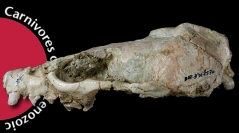

 Geodiversitas
42 (8) - Pages 103-121
Geodiversitas
42 (8) - Pages 103-121We describe dentognathic remains of four individuals of the poorly known mustelid Circamustela Petter, 1967 from the late Miocene sites of Batallones-3 and 5 (MN10, Torrejon de Velasco, Madrid, Spain). These new fossils allow us to describe Circamustela peignei n. sp., a more primitive species than Circamustela dechaseauxi Petter, 1967 from Can Llobateres (MN9, Vallès Penedès Basin, Spain). Circamustela peignei n. sp. shows, among other features, an M1 with a more developed metacone, a smaller metastylar area, a mesially located protocone, and a more developed m1 metaconid compared to that of C. dechaseauxi. The new taxon differs from most Euroasian Miocene marten-like mustelids, such as the middle Miocene martens “Martes” sansaniensis (Lartet, 1851), and “Martes” filholi Depéret, 1887, the vallesian Martes melibulla Petter, 1963 and the Turolian/Ventian Martes woodwardi Pilgrim, 1931, Martes ginsburgi Montoya, Morales & Abella, 2011, Pekania palaeosinensis (Zdansky, 1924), and Paramartes pococki Kretzoi, 1952, in smaller size, a reduced lingual platform of the M1 and a more reduced m1 talonid and m2. However, C. peignei n. sp. is closer to the Chinese and Greek hypercarnivorous Sinictis dolichognathus Zdansky, 1924. Circamustela spp., and Sinictis Zdansky, 1924 can be interpreted as adapted to a more carnivorous diet than those of the more generalist martens, such as Martes spp., Paramartes Kretzoi, 1952 and Pekania spp.
Spain, Carnivora, Mustelidae, Circamustela, Sinictis, Martes, cooccurrence, Neogene, Mustelids, new species